technical specifications Alfa Romeo MiTo 2014 Owner's Manual
[x] Cancel search | Manufacturer: ALFA ROMEO, Model Year: 2014, Model line: MiTo, Model: Alfa Romeo MiTo 2014Pages: 280, PDF Size: 8.79 MB
Page 126 of 280
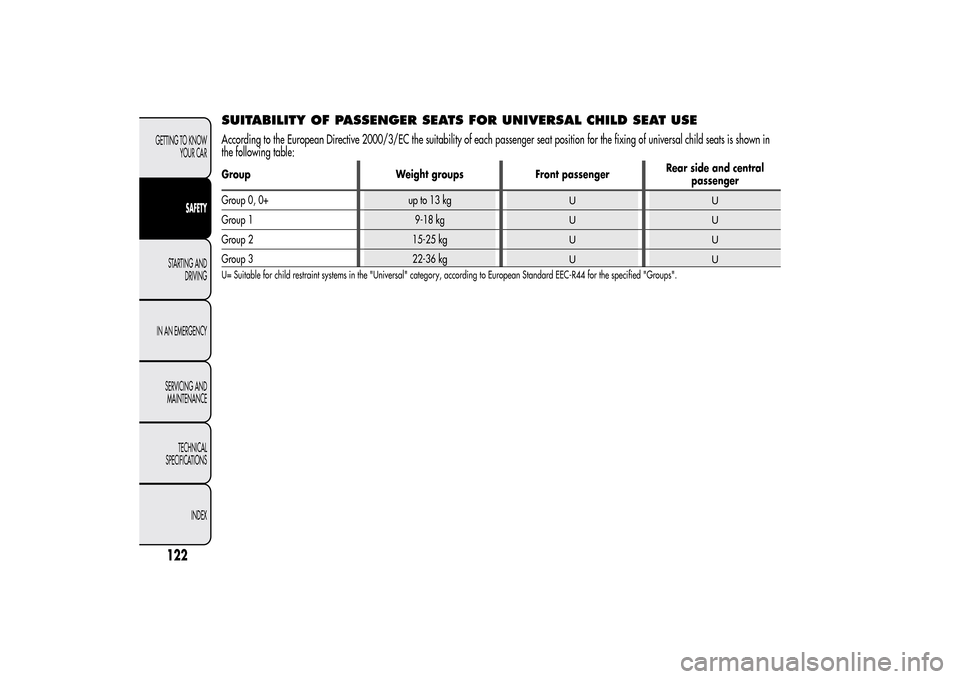
SUITABILITY OF PASSENGER SEATS FOR UNIVERSAL CHILD SEAT USEAccording to the European Directive 2000/3/EC the suitability of each passenger seat position for the fixing of universal child seats is shown in
the following table:Group Weight groups Front passengerRear side and central
passenger
Group 0, 0+ up to 13 kg
UU
Group 1 9-18 kg
UU
Group 2 15-25 kg
UU
Group 3 22-36 kg
UU
U= Suitable for child restraint systems in the "Universal" category, according to European Standard EEC-R44 for the specified "Groups".
122GETTING TO KNOW
YOUR CAR
SAFETY
STARTING AND
DRIVING
IN AN EMERGENCY
SERVICING AND
MAINTENANCE
TECHNICAL
SPECIFICATIONS
INDEX
Page 127 of 280
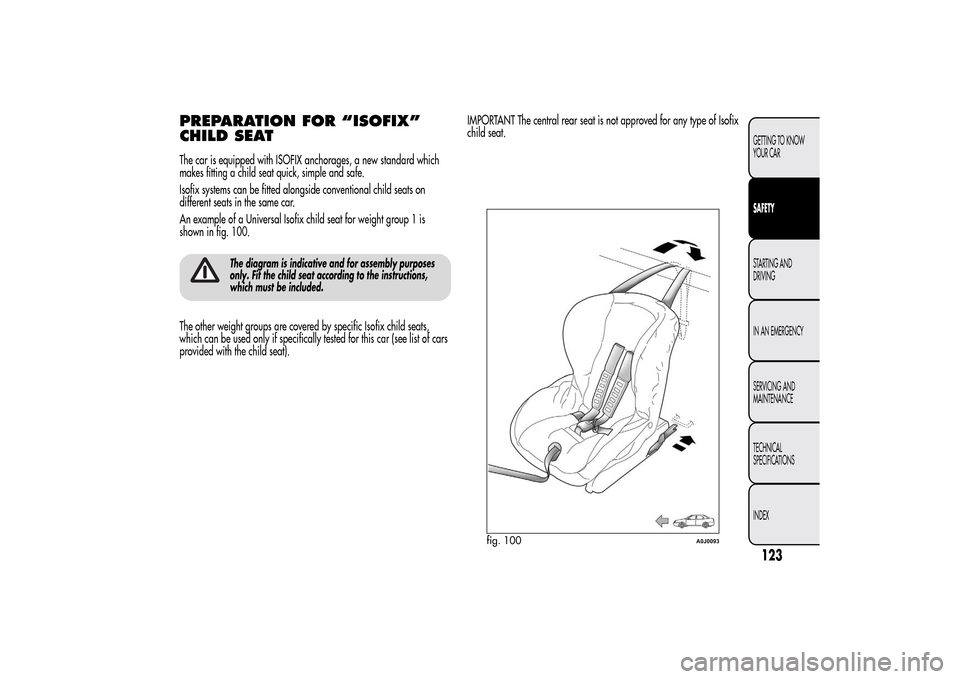
PREPARATION FOR “ISOFIX”
CHILD SEATThe car is equipped with ISOFIX anchorages, a new standard which
makes fitting a child seat quick, simple and safe.
Isofix systems can be fitted alongside conventional child seats on
different seats in the same car.
An example of a Universal Isofix child seat for weight group 1 is
shown in fig. 100.
The diagram is indicative and for assembly purposes
only. Fit the child seat according to the instructions,
which must be included.
The other weight groups are covered by specific Isofix child seats,
which can be used only if specifically tested for this car (see list of cars
provided with the child seat).IMPORTANT The central rear seat is not approved for any type of Isofix
child seat.
fig. 100
A0J0093
123GETTING TO KNOW
YOUR CARSAFETYSTARTING AND
DRIVING
IN AN EMERGENCY
SERVICING AND
MAINTENANCE
TECHNICAL
SPECIFICATIONS
INDEX
Page 128 of 280
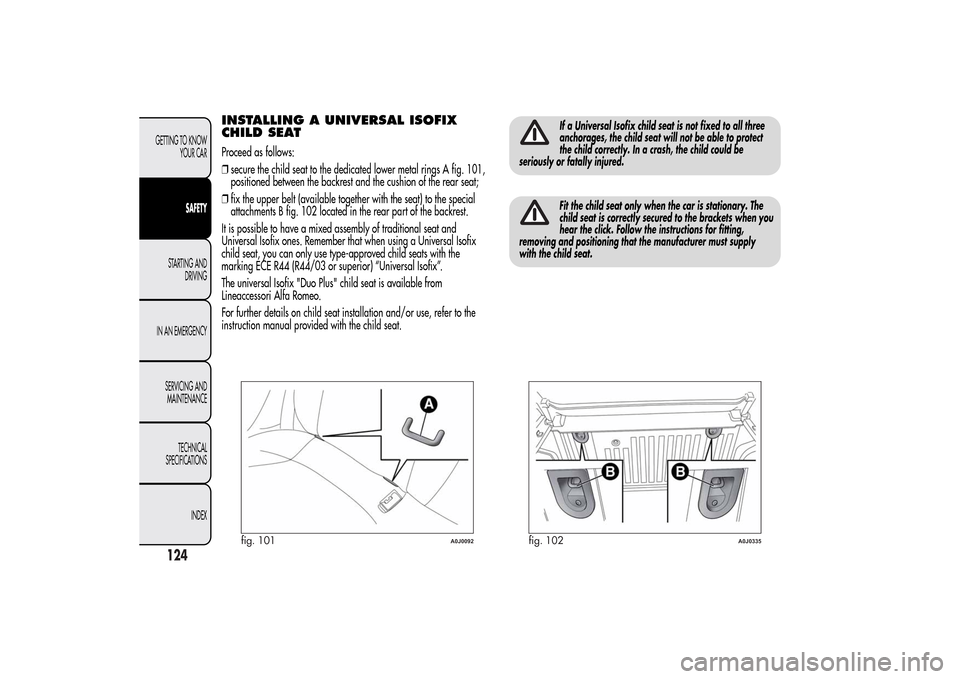
INSTALLING A UNIVERSAL ISOFIX
CHILD SEATProceed as follows:
❒secure the child seat to the dedicated lower metal rings A fig. 101,
positioned between the backrest and the cushion of the rear seat;
❒fix the upper belt (available together with the seat) to the special
attachments B fig. 102 located in the rear part of the backrest.
It is possible to have a mixed assembly of traditional seat and
Universal Isofix ones. Remember that when using a Universal Isofix
child seat, you can only use type-approved child seats with the
marking ECE R44 (R44/03 or superior) “Universal Isofix”.
The universal Isofix "Duo Plus" child seat is available from
Lineaccessori Alfa Romeo.
For further details on child seat installation and/or use, refer to the
instruction manual provided with the child seat.
If a Universal Isofix child seat is not fixed to all three
anchorages, the child seat will not be able to protect
the child correctly. In a crash, the child could be
seriously or fatally injured.Fit the child seat only when the car is stationary. The
child seat is correctly secured to the brackets when you
hear the click. Follow the instructions for fitting,
removing and positioning that the manufacturer must supply
with the child seat.
fig. 101
A0J0092
fig. 102
A0J0335
124GETTING TO KNOW
YOUR CAR
SAFETY
STARTING AND
DRIVING
IN AN EMERGENCY
SERVICING AND
MAINTENANCE
TECHNICAL
SPECIFICATIONS
INDEX
Page 129 of 280
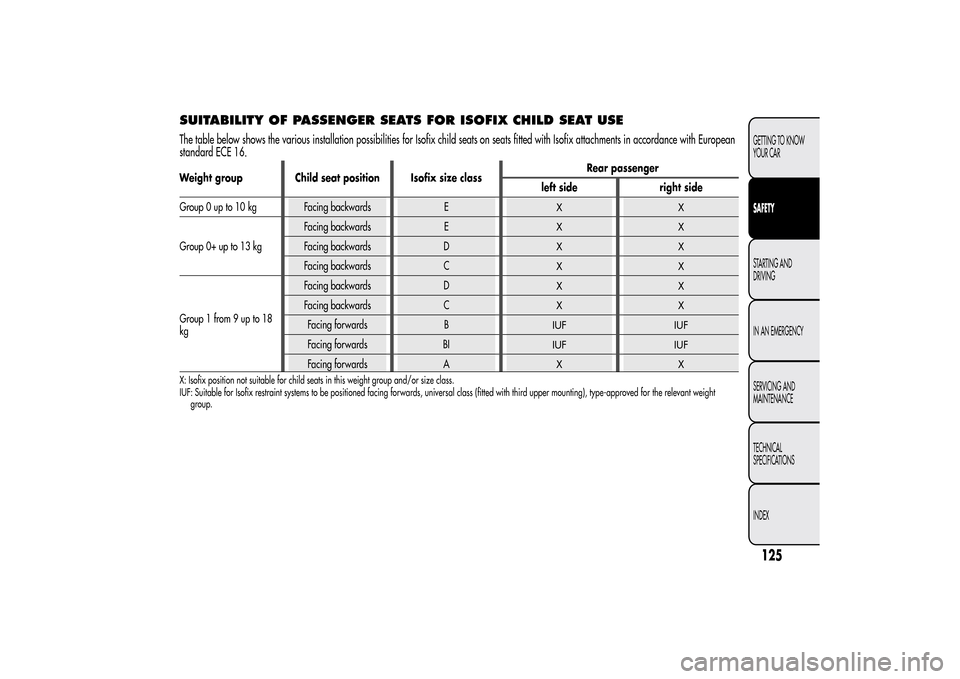
SUITABILITY OF PASSENGER SEATS FOR ISOFIX CHILD SEAT USEThe table below shows the various installation possibilities for Isofix child seats on seats fitted with Isofix attachments in accordance with European
standard ECE 16.Weight group Child seat position Isofix size classRear passenger
left side right side
Group 0 up to 10 kg Facing backwards E
XX
Group 0+ up to 13 kgFacing backwards E
XX
Facing backwards D
XX
Facing backwards C
XX
Group 1 from 9 up to 18
kgFacing backwards D
XX
Facing backwards C
XX
Facing forwards B
IUF IUF
Facing forwards BI
IUF IUF
Facing forwards A
XX
X: Isofix position not suitable for child seats in this weight group and/or size class.
IUF: Suitable for Isofix restraint systems to be positioned facing forwards, universal class (fitted with third upper mounting), type-approved forthe relevant weight
group.
125GETTING TO KNOW
YOUR CARSAFETYSTARTING AND
DRIVING
IN AN EMERGENCY
SERVICING AND
MAINTENANCE
TECHNICAL
SPECIFICATIONS
INDEX
Page 130 of 280
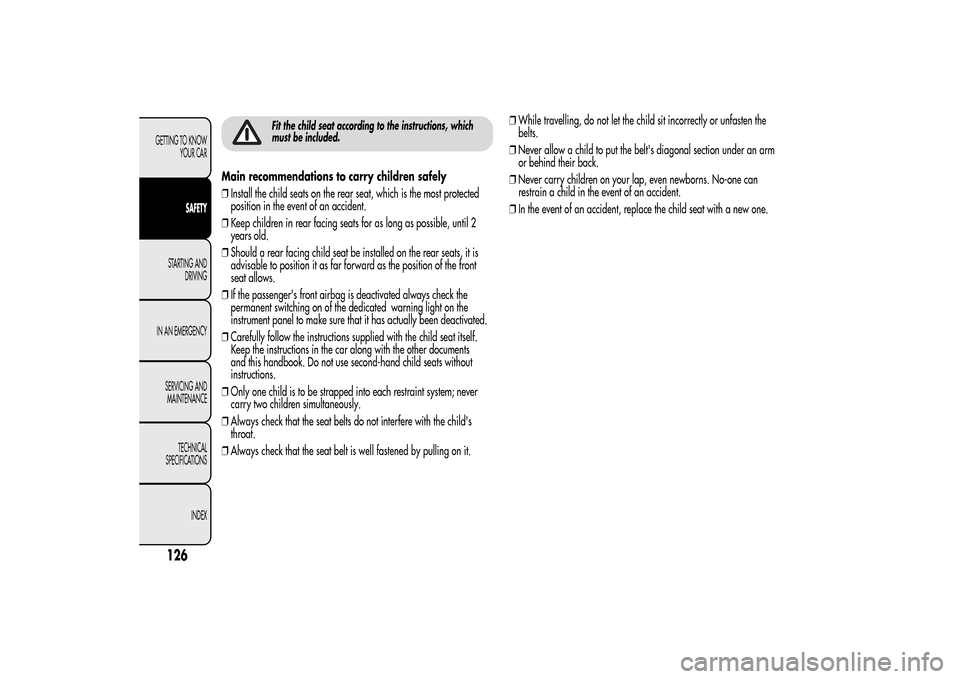
Fit the child seat according to the instructions, which
must be included.
Main recommendations to carry children safely
❒Install the child seats on the rear seat, which is the most protected
position in the event of an accident.
❒Keep children in rear facing seats for as long as possible, until 2
years old.
❒Should a rear facing child seat be installed on the rear seats, it is
advisable to position it as far forward as the position of the front
seat allows.
❒If the passenger's front airbag is deactivated always check the
permanent switching on of the dedicated warning light on the
instrument panel to make sure that it has actually been deactivated.
❒Carefully follow the instructions supplied with the child seat itself.
Keep the instructions in the car along with the other documents
and this handbook. Do not use second-hand child seats without
instructions.
❒Only one child is to be strapped into each restraint system; never
carry two children simultaneously.
❒Always check that the seat belts do not interfere with the child's
throat.
❒Always check that the seat belt is well fastened by pulling on it.❒While travelling, do not let the child sit incorrectly or unfasten the
belts.
❒Never allow a child to put the belt's diagonal section under an arm
or behind their back.
❒Never carry children on your lap, even newborns. No-one can
restrain a child in the event of an accident.
❒In the event of an accident, replace the child seat with a new one.
126GETTING TO KNOW
YOUR CAR
SAFETY
STARTING AND
DRIVING
IN AN EMERGENCY
SERVICING AND
MAINTENANCE
TECHNICAL
SPECIFICATIONS
INDEX
Page 131 of 280
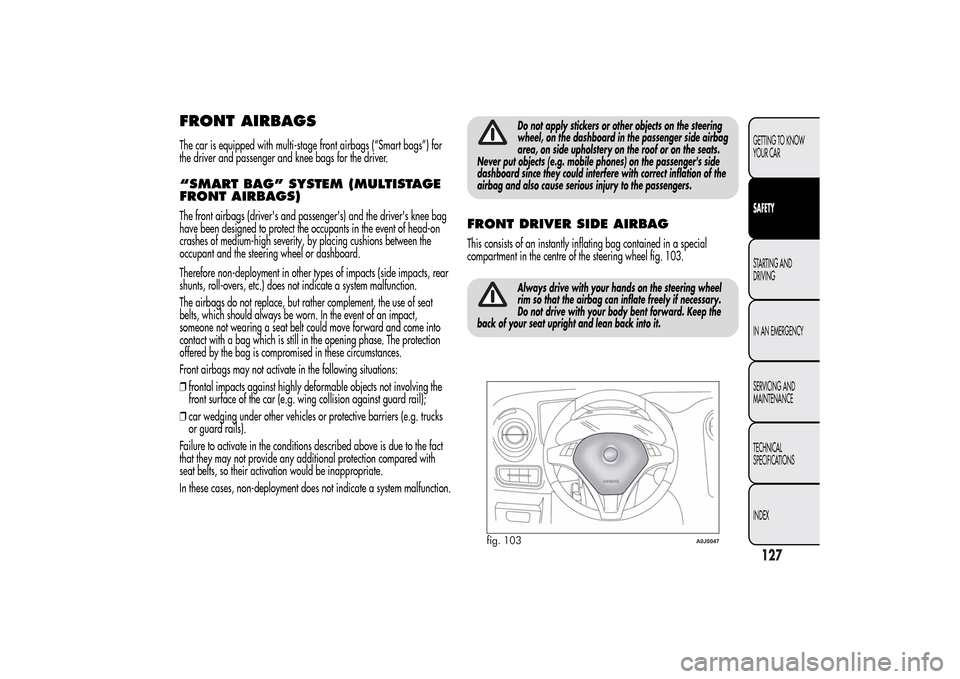
FRONT AIRBAGSThe car is equipped with multi-stage front airbags (“Smart bags”) for
the driver and passenger and knee bags for the driver.“SMART BAG” SYSTEM (MULTISTAGE
FRONT AIRBAGS)The front airbags (driver's and passenger's) and the driver's knee bag
have been designed to protect the occupants in the event of head-on
crashes of medium-high severity, by placing cushions between the
occupant and the steering wheel or dashboard.
Therefore non-deployment in other types of impacts (side impacts, rear
shunts, roll-overs, etc.) does not indicate a system malfunction.
The airbags do not replace, but rather complement, the use of seat
belts, which should always be worn. In the event of an impact,
someone not wearing a seat belt could move forward and come into
contact with a bag which is still in the opening phase. The protection
offered by the bag is compromised in these circumstances.
Front airbags may not activate in the following situations:
❒frontal impacts against highly deformable objects not involving the
front surface of the car (e.g. wing collision against guard rail);
❒car wedging under other vehicles or protective barriers (e.g. trucks
or guard rails).
Failure to activate in the conditions described above is due to the fact
that they may not provide any additional protection compared with
seat belts, so their activation would be inappropriate.
In these cases, non-deployment does not indicate a system malfunction.
Do not apply stickers or other objects on the steering
wheel, on the dashboard in the passenger side airbag
area, on side upholstery on the roof or on the seats.
Never put objects (e.g. mobile phones) on the passenger's side
dashboard since they could interfere with correct inflation of the
airbag and also cause serious injury to the passengers.
FRONT DRIVER SIDE AIRBAGThis consists of an instantly inflating bag contained in a special
compartment in the centre of the steering wheel fig. 103.
Always drive with your hands on the steering wheel
rim so that the airbag can inflate freely if necessary.
Do not drive with your body bent forward. Keep the
back of your seat upright and lean back into it.
fig. 103
A0J0047
127GETTING TO KNOW
YOUR CARSAFETYSTARTING AND
DRIVING
IN AN EMERGENCY
SERVICING AND
MAINTENANCE
TECHNICAL
SPECIFICATIONS
INDEX
Page 132 of 280
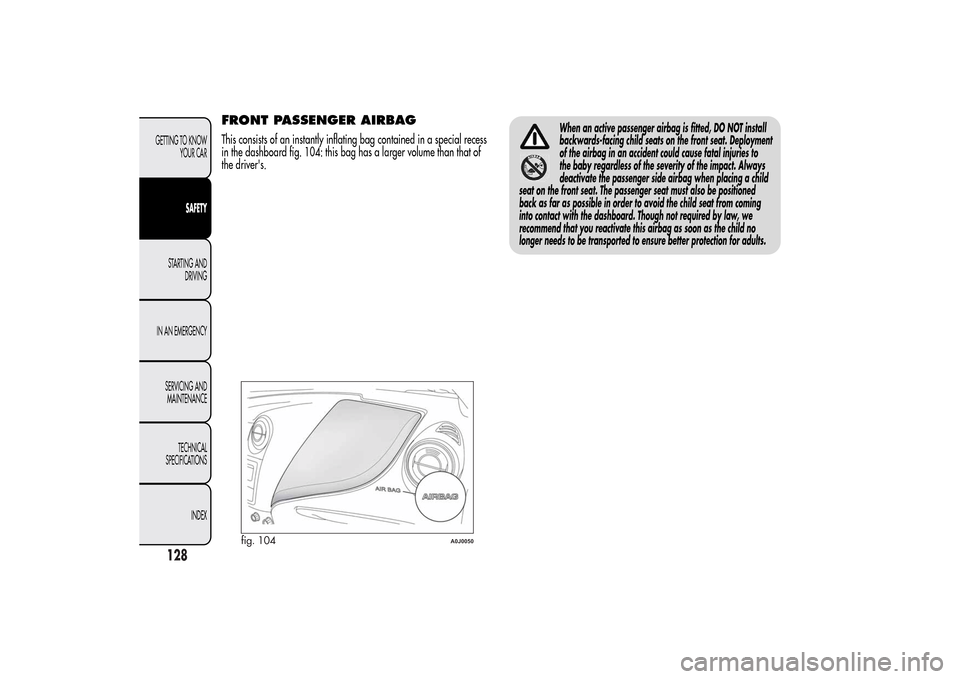
FRONT PASSENGER AIRBAGThis consists of an instantly inflating bag contained in a special recess
in the dashboard fig. 104: this bag has a larger volume than that of
the driver's.
When an active passenger airbag is fitted, DO NOT install
backwards-facing child seats on the front seat. Deployment
of the airbag in an accident could cause fatal injuries to
the baby regardless of the severity of the impact. Always
deactivate the passenger side airbag when placing a child
seat on the front seat. The passenger seat must also be positioned
back as far as possible in order to avoid the child seat from coming
into contact with the dashboard. Though not required by law, we
recommend that you reactivate this airbag as soon as the child no
longer needs to be transported to ensure better protection for adults.
fig. 104
A0J0050
128GETTING TO KNOW
YOUR CAR
SAFETY
STARTING AND
DRIVING
IN AN EMERGENCY
SERVICING AND
MAINTENANCE
TECHNICAL
SPECIFICATIONS
INDEX
Page 133 of 280
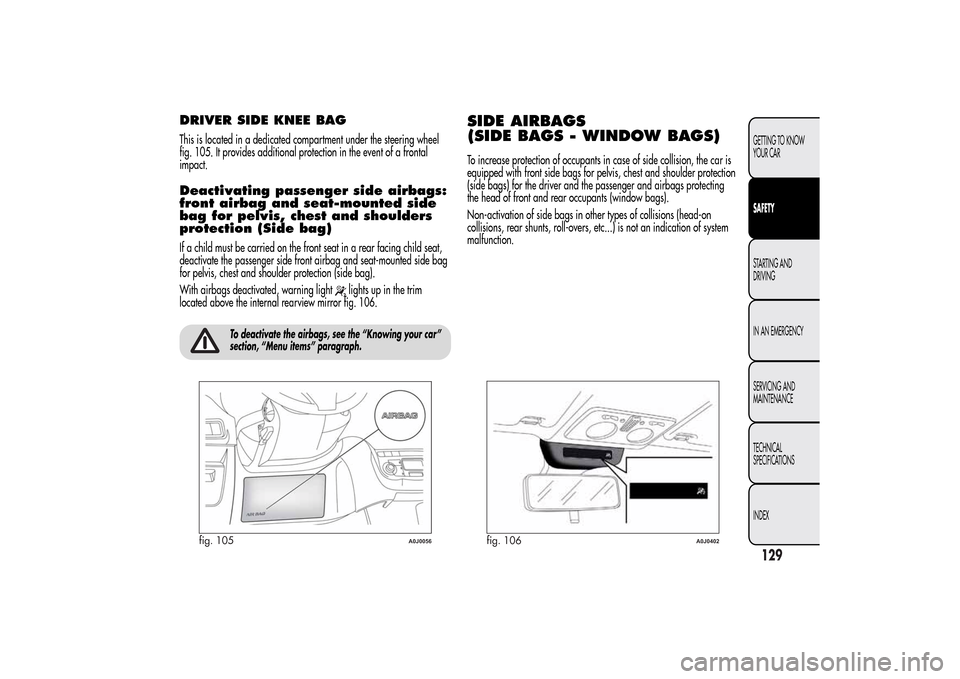
DRIVER SIDE KNEE BAGThis is located in a dedicated compartment under the steering wheel
fig. 105. It provides additional protection in the event of a frontal
impact.Deactivating passenger side airbags:
front airbag and seat-mounted side
bag for pelvis, chest and shoulders
protection (Side bag)If a child must be carried on the front seat in a rear facing child seat,
deactivate the passenger side front airbag and seat-mounted side bag
for pelvis, chest and shoulder protection (side bag).
With airbags deactivated, warning light
lights up in the trim
located above the internal rearview mirror fig. 106.
To deactivate the airbags, see the “Knowing your car”
section, “Menu items” paragraph.
SIDE AIRBAGS
(SIDE BAGS - WINDOW BAGS)To increase protection of occupants in case of side collision, the car is
equipped with front side bags for pelvis, chest and shoulder protection
(side bags) for the driver and the passenger and airbags protecting
the head of front and rear occupants (window bags).
Non-activation of side bags in other types of collisions (head-on
collisions, rear shunts, roll-overs, etc...) is not an indication of system
malfunction.
fig. 105
A0J0056
fig. 106
A0J0402
129GETTING TO KNOW
YOUR CARSAFETYSTARTING AND
DRIVING
IN AN EMERGENCY
SERVICING AND
MAINTENANCE
TECHNICAL
SPECIFICATIONS
INDEX
Page 134 of 280
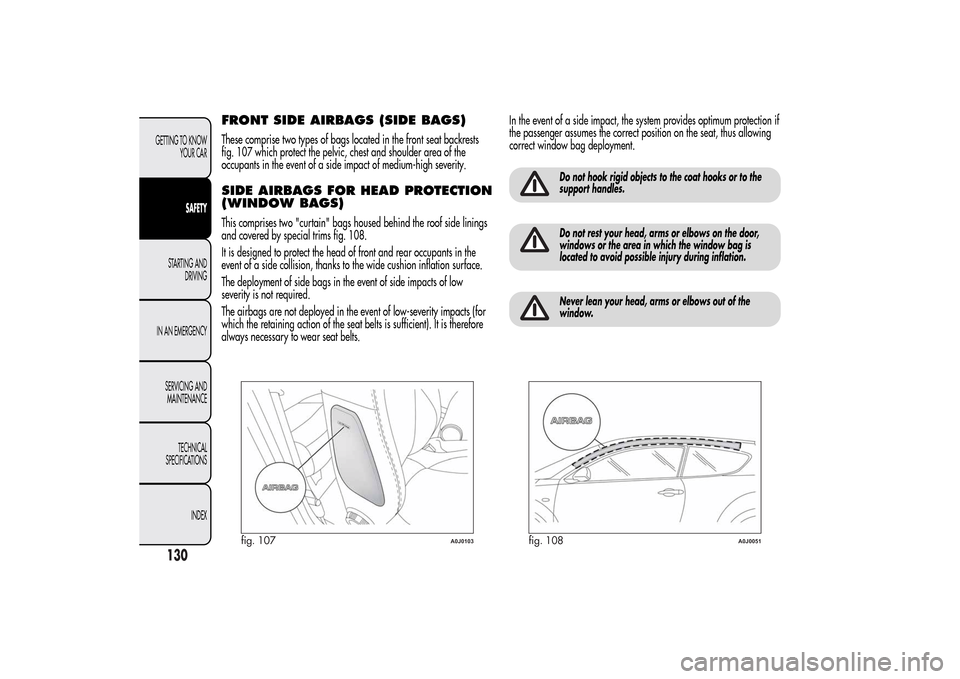
FRONT SIDE AIRBAGS (SIDE BAGS)These comprise two types of bags located in the front seat backrests
fig. 107 which protect the pelvic, chest and shoulder area of the
occupants in the event of a side impact of medium-high severity.SIDE AIRBAGS FOR HEAD PROTECTION
(WINDOW BAGS)This comprises two "curtain" bags housed behind the roof side linings
and covered by special trims fig. 108.
It is designed to protect the head of front and rear occupants in the
event of a side collision, thanks to the wide cushion inflation surface.
The deployment of side bags in the event of side impacts of low
severity is not required.
The airbags are not deployed in the event of low-severity impacts (for
which the retaining action of the seat belts is sufficient). It is therefore
always necessary to wear seat belts.In the event of a side impact, the system provides optimum protection if
the passenger assumes the correct position on the seat, thus allowing
correct window bag deployment.
Do not hook rigid objects to the coat hooks or to the
support handles.Do not rest your head, arms or elbows on the door,
windows or the area in which the window bag is
located to avoid possible injury during inflation.Never lean your head, arms or elbows out of the
window.
fig. 107
A0J0103
fig. 108
A0J0051
130GETTING TO KNOW
YOUR CAR
SAFETY
STARTING AND
DRIVING
IN AN EMERGENCY
SERVICING AND
MAINTENANCE
TECHNICAL
SPECIFICATIONS
INDEX
Page 135 of 280
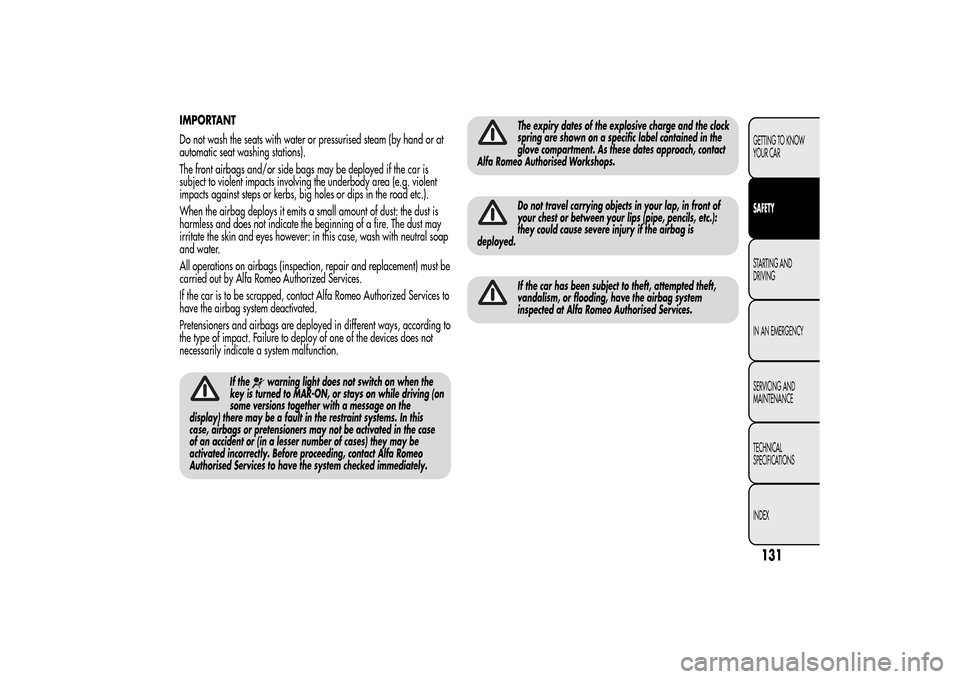
IMPORTANT
Do not wash the seats with water or pressurised steam (by hand or at
automatic seat washing stations).
The front airbags and/or side bags may be deployed if the car is
subject to violent impacts involving the underbody area (e.g. violent
impacts against steps or kerbs, big holes or dips in the road etc.).
When the airbag deploys it emits a small amount of dust: the dust is
harmless and does not indicate the beginning of a fire. The dust may
irritate the skin and eyes however: in this case, wash with neutral soap
and water.
All operations on airbags (inspection, repair and replacement) must be
carried out by Alfa Romeo Authorized Services.
If the car is to be scrapped, contact Alfa Romeo Authorized Services to
have the airbag system deactivated.
Pretensioners and airbags are deployed in different ways, according to
the type of impact. Failure to deploy of one of the devices does not
necessarily indicate a system malfunction.
If the
warning light does not switch on when the
key is turned to MAR-ON, or stays on while driving (on
some versions together with a message on the
display) there may be a fault in the restraint systems. In this
case, airbags or pretensioners may not be activated in the case
of an accident or (in a lesser number of cases) they may be
activated incorrectly. Before proceeding, contact Alfa Romeo
Authorised Services to have the system checked immediately.
The expiry dates of the explosive charge and the clock
spring are shown on a specific label contained in the
glove compartment. As these dates approach, contact
Alfa Romeo Authorised Workshops.Do not travel carrying objects in your lap, in front of
your chest or between your lips (pipe, pencils, etc.):
they could cause severe injury if the airbag is
deployed.If the car has been subject to theft, attempted theft,
vandalism, or flooding, have the airbag system
inspected at Alfa Romeo Authorised Services.
131GETTING TO KNOW
YOUR CARSAFETYSTARTING AND
DRIVING
IN AN EMERGENCY
SERVICING AND
MAINTENANCE
TECHNICAL
SPECIFICATIONS
INDEX